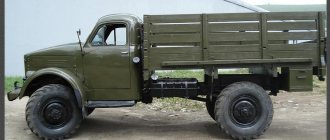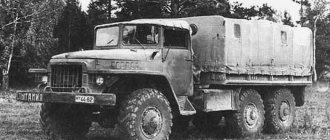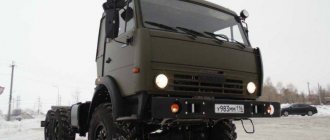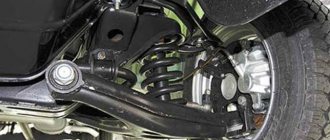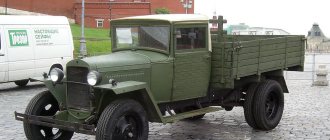GAZ-AA is a truck of the Nizhny Novgorod (1932) and later automobile plant in the city of Gorky, with a load capacity of 1,500 kg. The model is also called “lorry”. The debut 5-year plan for improving the economy of the Union of Soviet Socialist Republics (1928-1932) made it possible to begin a majestic development program.
The plan provided for the construction of more than 1,500 massive objects, including hydroelectric power plants, metallurgical plants, automobile and tractor factories. To implement all these projects, transport was needed, therefore there was a difficult strategic task - to organize a full-scale production of trucks. The entire GAZ model range.
Car history
By the end of the 1920s, truck series vehicles in the Union were mass-produced by only a couple of automobile enterprises: the First State Automobile Plant in Moscow (formerly AMO), as well as the Third State Automobile Plant in Yaroslavl. But their speed was not enough, since all two plants were created on the platform of pre-revolutionary capacities.
For example, by the beginning of the first five-year plan there were only 1,500 cars in the entire country. Therefore, no one was surprised that by the mid-1920s, the Soviet government planned to build the first automobile giant in the Union, the capacity of which would allow the production of about 100,000 vehicles per year.
When the necessary experience and technological resources were lacking, the best option was to buy production abroad. And the opinions of Russian experts were focused on an overseas country, or rather, Detroit.
This settlement, located in the north of America, was for the builders of socialism an exemplary automobile grandee, a city of the future in which settlers live and work, obeying a single and common functional plan. It was precisely in a similar format that the Russian automobile giant dreamed of constructing it.
They wanted to build residential areas for workers near the workshops and design all the accompanying infrastructure. As a result of the negotiations, ]General Motors[/anchor] decided to refuse involvement in the project, so the only variation remained ]Ford[/anchor]. This option suited the USSR quite well.
The very name of Henry Ford, along with his automobile empire, was often associated with technological solutions and rationalism. In addition, this company was known quite well in the Union of Soviet Socialist Republics, because, although not huge, but still stable purchases of Ford cars had been made since 1909.
On top of everything, the cars of the new Ford base, which in 1927-1928 replaced the previous generation “T”, were best suited for the needs of our country. The Ford-A passenger car and the Ford-AA semi-truck were simple, unpretentious, inexpensive and, very importantly, were well unified among themselves in terms of design.
According to the technical agreement, the USSR signed an agreement with Ford on May 31, 1929. They planned to build a car city not far from Nizhny Novgorod, near the village of Monastyrka, where there was a confluence of navigable rivers (Oka and Volga). The Union of Soviet Socialist Republics signed an agreement to build the enterprise along with a camp for those working there with the Austin Company in Cleveland.
The USSR began to cooperate with the famous American company Ford. As a result, a one and a half ton GAZ-AA truck, which was similar to the American, saw the light of day.
In addition to the construction of the automobile giant, the agreement with Ford provided for the operational construction of a pair of automobile assembly plants that would be located in Nizhny Novgorod and Moscow. They planned to assemble Ford cars from ready-made vehicle kits, because according to the contract, the Union of Soviet Socialist Republics was supposed to buy 72,000 vehicle kits.
These assembly shops provided the opportunity to start the production of cars even before the end of the construction of the enterprise in Nizhny Novgorod and were such plants for training production for those who worked there. To build and equip the branches, the American company decided to attract the already popular construction company Albert Kahn, Inc. in Russia.
Already at the onset of 1929, it was decided to allocate a share of the area of the enterprise of vehicles for agriculture “Gudok Oktyabrya”, which were located in the city of Kanavin, for the construction of the first automobile assembly plant. Already in the winter of the next year (1930), the debut Ford-AA trucks began to be assembled there from vehicle kits in America.
By the end of the same year, passenger cars, along with Ford trucks, began to be produced from the primary assembly line of an automobile enterprise in Moscow. But Nizhny Novgorod’s desires for an automobile town began to gradually melt away.
In part, this was due to the small project estimate, as well as due to the labor enthusiasm of the producers, which in an interesting way was able to harmonize with the negligence and lack of agreement in the decisions and work of many management bodies.
They were able to build the largest automobile enterprise in European countries at the right time, but the result was far from the “airy” dreams of an industrial town of the future. The new building near Monastyrka was popularly nicknamed Sotsgorod, and after 2 years it acquired the official status of the Avtozavodsky district of Nizhny Novgorod.
While the second half of the first month of 1932 was underway, at the enterprise prepared for the start of its designed capacity, they were able to master the production of the cylinder block, along with the crankshaft, frame side members and other other parts. Due to the lack of consistent supplies of components from suppliers (more precisely, sheet steel), the cabins of “pre-production” vehicles began to be assembled using plywood.
On January 29 of the same year, the debut NAZ-AA vehicles were released from the assembly line of the enterprise in Nizhny Novgorod. In October (7th) Nizhny Novgorod was renamed Gorky, therefore the name of the car was changed. At the end of 1932, the production of cargo vehicles at the Gorky Automobile Plant was about 60 vehicles every day. The name of the truck became GAZ-AA.
The GAZ AA car turned out to be reliable and durable, and lost, perhaps, to one real rival in the USSR car market - the Moscow three-ton ZIS-5. However, the automobile enterprise in Gorky had much more production capacity than ZIS.
Therefore, the lorry was supposed to become a “multifunctional soldier” of the national economy, and Gorky specialists designed various “civilian” and “military” vehicles and improved existing standard vehicles.
In order to test the weak structural points of the gas AA lorry truck, at the end of 1932, trucks took part in a test run from Nizhny Novgorod to Moscow and back. Six months later (in 1933) they took part in the summer extreme “Karakum” run.
The lion's share of standard breakdowns was explained by the low quality of components supplied by subcontractors. While 1933 was going on, automobile factories in Moscow and Gorky fully used the arsenal of vehicle kits from America and migrated to creating cars from spare parts of their production.
Within 3 years, the Gorky Automobile Plant was able to master the production of the brand new GAZ-M power unit (50 horsepower), which was a forced version of the GAZ-A engine. One and a half ton boats began to be equipped with the latest engine in 1938.
At the same time, a brand new steering device, synchronized with the Emka, was released, along with strengthening the fastening of the springs installed at the rear. A similar modification acquired the name GAZ-MM. The Gorky Automobile Plant assembled the last lorry on October 10, 1949.
The Ulyanovsk Automobile Plant, which had been assembling MM since 1947, stopped assembling these models only by 1951. From 1932, before the start of hostilities, the KIM enterprise, together with the car assembly plant in Rostov-on-Don, produced more than 800,000 1.5-ton “AA” and “MM” trucks. During the war, GAZ produced 102,300 cargo vehicles.
Wooden cabin
The GAZ-AA lorry has been assembled entirely from Soviet-made components since 1933. The cabins of the first cars were made of wood, and starting in 1934, a metal module with a canvas roof was installed on the car.
The technologically advanced GAZ-AA truck was designed on a frame-type chassis with leaf spring suspension. The complete absence of shock absorbers made the car's ride unstable and harsh. However, the car successfully carried out cargo transportation tasks and rarely broke down. GAZ-AA engines were distinguished by their unpretentiousness and high maintainability. They could run on the lowest-grade petroleum products, low-octane gasoline, and even kerosene in the hot season.
Appearance
Since the fall of 1940, they began to install a powerful towing device on it along with fittings for mounting a spare wheel of a different mechanism. The material of the car was changed as soon as the Great Patriotic War began. If we talk about metal, then they began to save it, therefore the front part eventually lost all the parts that were not considered urgently needed.
The wings, which were angular, began to be bent from roofing iron, and the roof, along with the doors, was made using tarpaulin. They decided to install the headlight, along with the wiper, only on the driver’s side, and the front brakes, along with the muffler and bumper, were not installed at all.
Beginning in 1943, the canvas flaps on the side parts of the cabin began to be replaced with wide wooden doors. A simplified modification of the GAZ-MM continued to be produced even after the end of hostilities, but the cars received full metal doors, mufflers, front brakes, a bumper and a pair of headlights.
The tarpaulin of the rear wall of the cabin had a rectangular window. This is clearly visible in the photo. GAZ-AA was a fairly simple, but successful and technologically advanced truck, which was not picky and could not run on the highest quality fuel.
The front of the Lawn was fairly simple. There was a simple bumper, a pair of headlights and a large rectangular radiator grille. Two front lighting lamps were mounted on the wheel fenders and the front hood. An audible signal was installed under one of the lamps.
The hood lids opened like gull wings, providing convenient free space for repairing the power unit. Nearby there was a fuel tank designed for 40 liters. The spare wheel was located under the frame at the rear of the chassis. The side part was occupied by a door with smooth wheel fenders and a comfortable footrest.
Also, the wooden body smoothly transitioned from the side to the rear. The side and rear sides were folding. Also on the back of the vehicle, on the left side, rear lighting could be found.
Modernization
The GAZ-AA lorry went into mass production in January 1932, and the assembly shops of the Gorky Automobile Plant immediately showed high rates of truck production. 60 cars rolled off the assembly line per day, and there was still potential for acceleration. The Soviet version differed from the American model in a number of ways. Instead of a tin one, a cast clutch housing was installed, a worm-gear steering mechanism was strengthened, and an air filter was installed on the carburetor. The body was immediately redesigned, the onboard version was manufactured according to domestic drawings. Later, Soviet designers developed a unique dump truck version of the “lorry,” which was distinguished by the fact that the body did not need to be tipped over. The load slid under its own weight along a specially designed bottom of the body. It was enough to open the tailgate.
Specifications
Power unit
For all its simple qualities, the GAZ-AA was technically quite advanced. As an engine, it had a four-cylinder engine, the displacement of which was 3.285 liters and which produced about 42 horses. It was the same power unit that was installed on the GAZ-A passenger car.
It was an in-line carburetor, four-stroke, overhead valve, water-cooled. Fuel consumption per 100 km at full load (driving on the highway) was 18.5 liters. Maximum speed at 70 km/h.
Transmission
The engine transmitted torque to the drive axle through a single-disc dry friction clutch and a four-speed manual gearbox. It appears to be a three-way mechanism and has four forward gears and one reverse. The box was not synchronized. Wheel drive is rear.
Suspension
It was represented by dependent mechanisms. The wheels mounted in front were suspended on one transversely mounted semi-elliptical spring, where there were push rods that could transfer the load to the frame.
The wheels mounted at the rear were mounted on a pair of longitudinal cantilever springs and were devoid of any shock absorbers. As a design feature, there was a rear suspension mechanism together with a transmission, where a driveshaft was used as a longitudinal rod, which rested on a bronze bushing.
Brake system
The service brake had a mechanical drive. The brakes were foot type with shoe mechanisms. All wheels had drum brakes.
Steering
The steering mechanism had a worm and a double roller, and the gear ratio was 16.6.
Specifications
| Engine | gasoline carburetor 4-stroke lower valve |
| Number of cylinders | 4 |
| Working volume | 3285 cm³ |
| Max. power | 40/2200 hp/rpm |
| Max. torque | 15.5 (152) kgf*m (Nm) |
| Drive unit | rear |
| Transmission | manual, 4-speed, not synchronized |
| Front suspension | dependent, on a transverse semi-elliptical spring with push rods |
| Rear suspension | dependent, on two longitudinal cantilever springs, without shock absorbers |
| Front/rear brakes | drums |
| Maximum speed | 70 km/h. |
| Length | 5335 mm. |
| Width | 2040 mm. |
| Height | 1970 mm. |
| Wheelbase | 3340 mm. |
| Ground clearance | 200 mm. |
| Curb weight | 1810 kg. |
| Tires | 6.50-20 |
| Load capacity | 1500 kg. |
| Fuel consumption | mixed cycle 20.5 |
| Fuel tank capacity | 40 l. |
Update
In 1938, the GAZ-AA lorry received a new GAZ-MM engine with a power of 50 hp. s., which was previously installed on the Molotovets-1 car under the designation GAZ-M1. In addition to the modernized engine, the lorry was equipped with an improved steering mechanism and a driveshaft on needle bearings. The chassis was spring-type, without shock absorbers.
Since the “lorry” is a technologically advanced vehicle, and its production was launched in a short time, the model became indispensable in the national economy of the USSR. At that time, a car's carrying capacity of 1.5 tons was considered quite sufficient. During the harvest season, hundreds of cars were driven into the fields, which quickly transported the crop for processing and then returned to their vehicle fleets. The lorry was considered a universal vehicle. He was reliable and unpretentious.
Advantages and disadvantages
Pros of the car
- High-quality and reliable body metal;
- Good ground clearance;
- Excellent vehicle cross-country ability;
- Small dimensions of the truck;
- There is a windshield wiper (on the driver's side);
- Unpretentiousness in fuel;
- Clear service;
- American roots of Ford;
- The windshield extends;
- Trailers can be transported.
Cons of the car
- There are no hydraulic power steering and brake systems of the car;
- There are no steering wheel and sofa adjustments;
- Ascetic look of the interior;
- Weak power unit;
- Simple and cool cabin;
- Dependent suspension;
- High fuel consumption;
- Low transportable weight;
- Lack of any comfort.
[edit] Basic modifications
GAZ-MM
- GAZ-AAA
is a three-axle off-road vehicle with a load capacity of 2 tons. Created on the basis of a licensed Ford-Timken truck. Produced from to 1943. 37,373 vehicles were produced. - BA-10
is an armored vehicle delivered to the Leningrad Front. It is a consequence of the remaining BA-10M armored hulls, which were placed on the GAZ-MM biaxial chassis (autumn 1941 - spring 1942). - GAZ-03-30
is a general purpose bus with 17 seats. Produced at GZA (Gorky Bus Plant) from 1933 to 1942 and from 1946 to 1950. - GAZ-410
is a dump truck on the GAZ-AA and MM chassis with a lifting capacity of 1.2 tons with an all-metal self-unloading body. Produced from 1934 to 1946. - GAZ-42
is a gas generator modification of GAZ-AA; firewood (wooden logs) was used as fuel for it. Produced from 1938 to 1950, the rated carrying capacity is 1 ton, the real one is less (depending on the mass of the fuel). - GAZ-43
is a gas generator modification, the fuel for which was coal. It was produced in small batches from 1938 to 1941, and had a smaller gas generator installation than its predecessor. - GAZ-44
is a gas-cylinder modification that runs on compressed gas. It was released in a small batch in 1939. - GAZ-55
is an ambulance vehicle produced from 1938 to 1945. The most popular ambulance of the Red Army during the Great Patriotic War. - GAZ-60
is a serial half-track modification. Produced from 1938 to 1943. - GAZ-65
is a wheeled and tracked all-terrain modification. In 1940, an experimental batch was produced, but the modification showed the complete unsuitability of such a wheeled-tracked propulsion device in front-line conditions and in the rear, in particular, fuel consumption exceeded 60 liters per 100 kilometers. - NATI-3
is an experimental half-track modification. Tested from 1934 to 1936. - PMG-1
is a fire truck, the years of production are not reliably known. The most popular Soviet firefighting vehicle before the Great Patriotic War.
Let's sum it up
Any merger of Russian automobile companies with foreign companies has always benefited the domestic automobile industry, and GAZ-AA is no exception. Its similarity with foreign variations can be seen in the photo. The car turned out to be surprisingly simple, but functional and in demand.
At that time, there were no environmental standards yet, so the fuel consumption of its weak power plant was 20 liters per 100 kilometers. The appearance of the car was very simple, and there was not even a hint of sophistication, because one should not forget the year of its production and the purpose of its release.
It was supposed to serve faithfully on almost all road surfaces. The truck has a good ride height, rear-wheel drive and a payload of 1,500 kg. This was not a record, but in the pre-war period and during the hostilities, the Union of Socialist Republics was in dire need of light-duty vehicles.
Only two people, including the driver, could fit inside the cabin. The interior was also very simple, which once again emphasized the purpose of the car - for work. Russian specialists were able to take the best from the well-known American company, which made it possible to make a successful car.
Decades later, the Gorky Automobile Plant will more than once resort to help and purchase foreign vehicles and spare parts. Today you can find this model from private collectors and in museums.
We advise you to read the article: GAZ - the history of car production.
Flaws
The weakest point of the lorry was the starter and battery. Their service life barely reached six months, then the unit broke down and the battery had to be repaired. Usually the car was started with a crank.
Another significant problem in the operation of GAZ-AA was the acute shortage of tires. It got to the point that the rear axle of the car was not equipped with four wheels, as it was supposed to be according to the passport, but only two, because of which the load-carrying capacity of the car decreased.
And yet, the “lorry” was the most popular Soviet car in the pre-war and war years. The GAZ-AA chassis was also used for modified developments - these were ambulances, various tanks, light and acoustic installations, repair mobile "flights", anti-chemical, hygienic and sanitary auto laboratories, radio stations and early warning radio systems, charging and lighting stations and aviation starting units.
GAZ-AA photo
Read further:
Ural-5920
History of the Lutsk Automobile Plant
History of FAW
GAZ-67
KrAZ-256
History of Renault
Truck design
The experience gained during the war and familiarity with the latest models of captured and allied cargo vehicles from the leading automotive powers of the world allowed Soviet developers to create a simple but very functional vehicle based on an optimal hood layout. With a relatively short wheelbase, the engine and cab moved forward made it possible to install a fairly long and spacious cargo platform.
The truck's frame was a simple "ladder" structure, in which two long side members were connected to each other using five cross beams. The cabin and body, suspension and power unit were attached to the frame. The body platform was connected to the frame using stepladders. To transport large light loads, special slots were provided in the side frame of the body for extending the sides.
Frame and rear axle
For the first time in the Soviet automobile industry, the design of the GAZ-51 solved the problem of ensuring equal strength of all systems and components of the vehicle. Also, for the first time, such modern solutions at that time as an aluminum cylinder head, inserted valve seats, adjustable mixture heating, an oil cooler and double oil filtration, closed crankcase ventilation, thin-walled bimetallic crankshaft liners and easily removable brake drums were successfully tested. In terms of technology, the use of new wear-resistant types of cast iron and chrome plating of a number of important parts were mastered.
For the post-war production of the GAZ-51, the engine was significantly improved, which made it possible to significantly improve its technical characteristics. In the design of trucks, a hydraulic brake cylinder was used, which became much more effective than mechanical brakes. At the same time, the vehicle's own weight steadily decreased during periodic improvements, amounting to just under 2.3 tons by 1962.
The truck's cabin had modern outlines for those years and was consistently improved. On the first production cars, the cabin roof and doorways were lined with wood, and the top was covered with plywood and tarpaulin. Soon, door frames and a number of other parts of the cabin began to be made from metal. After 1955, it became all-metal, and a year later a heating system appeared in it. For ventilation in hot weather, the windshields could be raised to an almost horizontal position. A windshield wiper was installed on the driver's side.
Engine GAZ-51
Modifications
A modernized version of the “Lorry” with a more powerful 50 horsepower engine, a new cardan, steering and reinforced suspension. Produced from 1938 to 1950.
A simplified version of the “Lorry”. The doors were replaced with triangular side barriers and roll-up canvas doors, the fenders were made of roofing iron using a simple bending method, there were no brakes on the front wheels, only one headlight was left, and the side walls did not fold down.
GAZ-AAA
An off-road truck with a 6x4 wheel arrangement and a load capacity of 2 tons. Produced from '34 to '43. 37,373 cars were produced, that's a fun number! At its base, both staff buses and military equipment were produced - armored vehicles, chemical combat vehicles and armored personnel carriers.
GAZ-410
A dump truck on a GAZ-AA chassis with an all-metal body and a lower load capacity of 1.2 tons. Produced from 34 to 46 years.
GAZ-42
The truck, with a gas generator unit, built on the basis of the “Lorry”, ran on solid fuel and literally drove on firewood. The engine power was 35-38 horsepower, and the load capacity without firewood was 1 ton, with a full load of wood just over 800 kg.
GAZ-43
The car, like the GAZ-42, ran on solid fuel, but coal was used instead of firewood. The gas generating unit was smaller in size. Years of production: 1938 – 1941.
GAZ-44
Modification with a gas cylinder installation, liquefied petroleum gas was used as fuel. Produced in 1939.
GAZ-55
Produced in 12,044 copies, the Soviet ambulance bus is based on a GAZ-MM chassis. Serial production was organized in 1938 at the Gorky Automobile Assembly Plant (since 1940, a GAZ bus branch). In 1942, the design of the machine was significantly simplified. The front fenders were no longer made using the deep stamping method, but just as on the GAZ-MM-V they were bent from a flat sheet, the rear mudguards were made in a similar way, only the left headlight was installed, there were no front brakes.
Production of the GAZ-55 continued after the war. Discontinued at the end of 1950
GAZ-60
Half-track off-road truck. Produced from 1938 to 1943 in small batches. In total, just over 1,000 copies of the GAZ-60 and its modifications were produced.
GAZ-65
Tracked-wheeled modification of GAZ-AA. Tracks were placed on the standard rear wheels, and these rear wheels drove the car. In 1940, a pilot batch of about 2,000 copies was produced. The design turned out to be unsuccessful and was never returned to. Experience in the design, testing and operation of such vehicles has shown that the creation of half-tracks on the basis of standard vehicles led to their extremely low durability, since when installing a caterpillar drive, all other units remained unchanged, and due to the increase in the load-bearing capacity of the propulsion unit, they worked with large overloads. Frequent breakdowns and structural failures were typical of half-track operation.
GAZ-03-30
A civilian bus on a GAZ-AA chassis designed for 17 passengers. The body frame was made of wood with metal cladding. The most common bus model of the pre-war era. Years of production 1933-1950
PMG-1
The Gorky Automobile Plant produced the first fire trucks on the AMO-F15 chassis back in 1926. In order to turn the “Lorry” into a fire truck, the first step was to remove the driveshaft and driver’s seat from it. A transfer case was installed behind the gearbox, and a D-20 centrifugal pump was installed in the rear of the car. The lower output shank of the transfer case was connected by a driveshaft to the main gear, and the upper one was connected to the pump.
A wooden superstructure with side seats for the fire brigade was installed on the chassis. It contained a tank of water for providing first aid in case of fire. On the sides, reels with folding sleeves were attached to the backs of the seats. A three-legged retractable ladder, pick-up sleeves, a spare wheel and rubber trunks were fixed on top of the superstructure, inside the superstructure there was a stander and a bat lantern, and in its drawers there were various fire-fighting accessories (a tee splitter, pick-up nets, etc.) and entrenching tool. A foam generator, a double splitter and two fire extinguishers were attached to the front fenders, and swivel brackets were attached to the rear of the car, on which a large reel with folding sleeves was suspended. To control the machine when supplying water during a fire, appropriate rods were placed inside the superstructure, and control handles were installed in its rear part.


